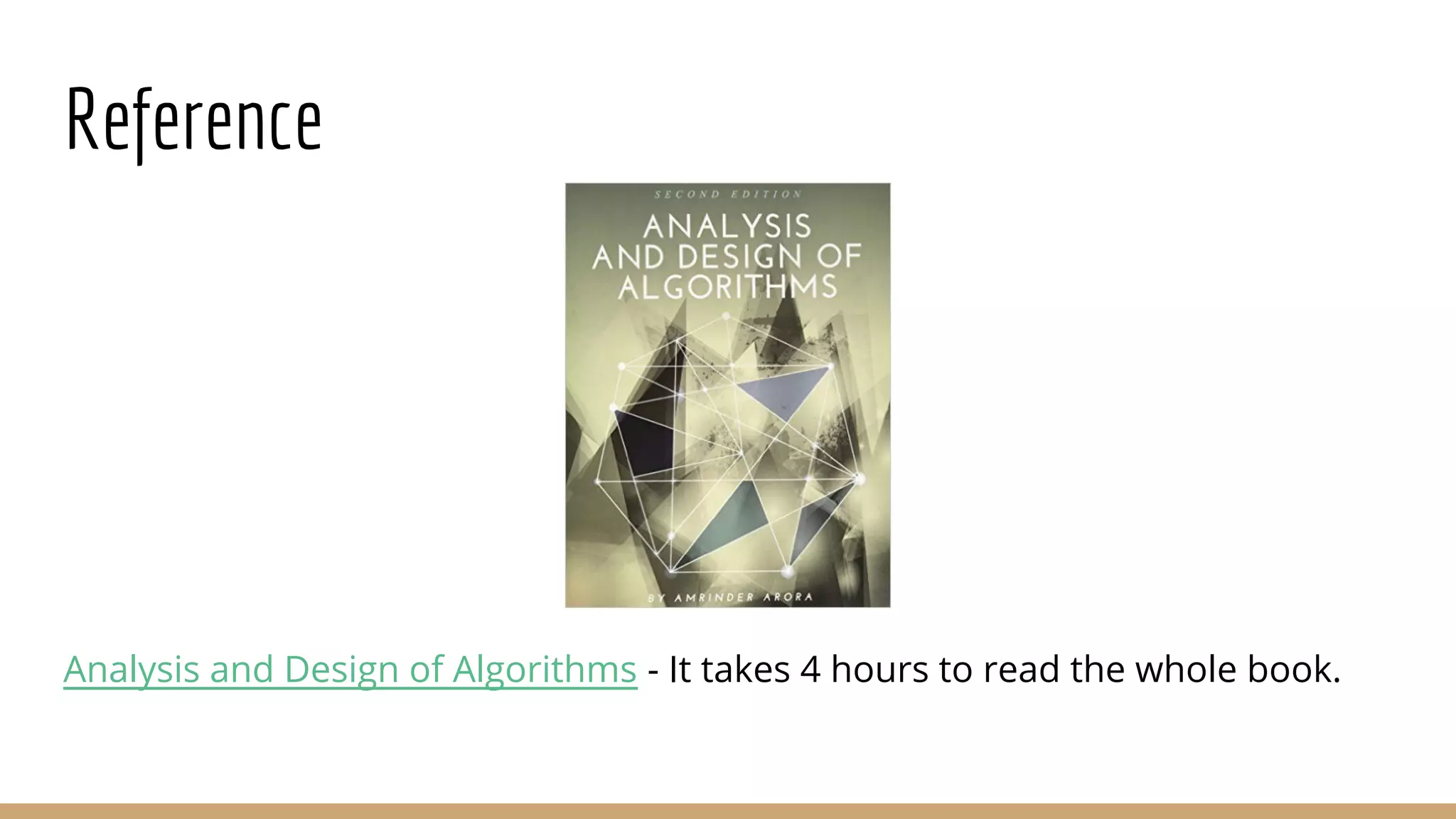The document provides an overview of algorithms, focusing on the definition, types of data structures, and various algorithm design techniques such as dynamic programming. It elaborates on dynamic programming concepts including optimal substructure and memoization, illustrated with examples like the Fibonacci sequence and coin change problem in Python. Additionally, it includes challenges for practical application and references material for further reading on algorithms.





![Example: Compute n-th Fibonacci number
Recursion
function fib(int n) {
If (n <= 2) {
return 1;
}
return fib(n-1) + fib(n-2);
}
Dynamic Programming
long a[] = new long[n + 1];
a[1] = a[2] = 1
for (int i=3; i <=n; i++) {
a[i] = a[i-1] + a[i-2];
}
return a[n];](https://crownmelresort.com/image.slidesharecdn.com/algorithmspracticeandproblemsolving-dynamicprogramming-170304043754/75/Algorithms-practice-and-problem-solving-dynamic-programming-6-2048.jpg)





![Python Solution: Fibonacci Finding Challenge
def fibonacci(n):
if n < 2:
return n
if not n in memory.keys():
memory[n] = fibonacci(n-1) + fibonacci(n-2)
return memory[n]
memory = {}
n = int(raw_input())
print(fibonacci(n))](https://crownmelresort.com/image.slidesharecdn.com/algorithmspracticeandproblemsolving-dynamicprogramming-170304043754/75/Algorithms-practice-and-problem-solving-dynamic-programming-12-2048.jpg)
![Python Solution: Coin Change Challenge
Recursion
def count(sum_, coins):
if len(coins) == 0:
return 0
if sum_ < 0:
return 0
if sum_ == 0:
return 1
return count(sum_ - coins[0], coins) + count(sum_, coins[1:])
if __name__ == "__main__":
import sys
N, M = map(int, sys.stdin.readline().strip().split(' '))
coins = map(int, sys.stdin.readline().strip().split(' '))
print count(N, coins)](https://crownmelresort.com/image.slidesharecdn.com/algorithmspracticeandproblemsolving-dynamicprogramming-170304043754/75/Algorithms-practice-and-problem-solving-dynamic-programming-13-2048.jpg)
![Python Solution: Coin Change Challenge
Memoization
count_dict = {}
def count(sum_, coins):
if len(coins) == 0:
return 0
if sum_ < 0:
return 0
if sum_ == 0:
return 1
key = (sum_, tuple(coins))
if key not in count_dict:
count_dict[key] = count(sum_ - coins[0], coins) + count(sum_, coins[1:])
return count_dict[key]
if __name__ == "__main__":
import sys
N, M = map(int, sys.stdin.readline().strip().split(' '))
coins = map(int, sys.stdin.readline().strip().split(' '))
print count(N, coins)](https://crownmelresort.com/image.slidesharecdn.com/algorithmspracticeandproblemsolving-dynamicprogramming-170304043754/75/Algorithms-practice-and-problem-solving-dynamic-programming-14-2048.jpg)
![Python Solution: Coin Change Challenge
Dynamic Programming
def count(N, coins):
numWays = [[1] + N * [0] for j in xrange(len(coins) + 1)]
for i in xrange(1, len(coins) + 1):
for j in xrange(1, N + 1):
numWays[i][j] = numWays[i-1][j] + (numWays[i][j - coins[i-1]]
if coins[i-1] <= j else 0)
return numWays[-1][-1]
if __name__ == "__main__":
import sys
N, M = map(int, sys.stdin.readline().strip().split(' '))
coins = map(int, sys.stdin.readline().strip().split(' '))
print count(N, coins)](https://crownmelresort.com/image.slidesharecdn.com/algorithmspracticeandproblemsolving-dynamicprogramming-170304043754/75/Algorithms-practice-and-problem-solving-dynamic-programming-15-2048.jpg)
